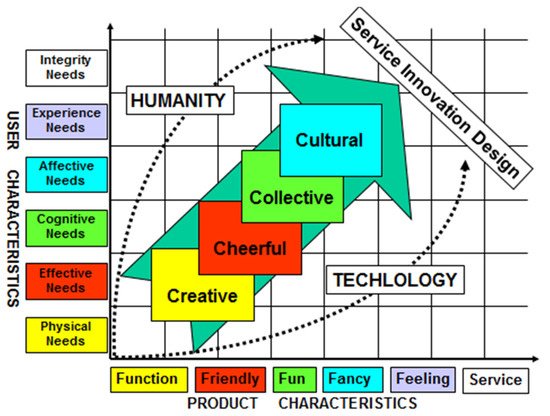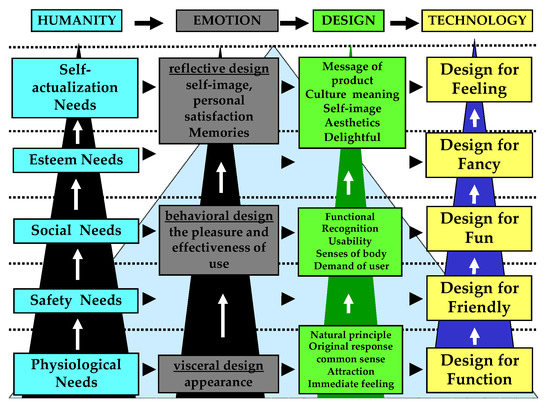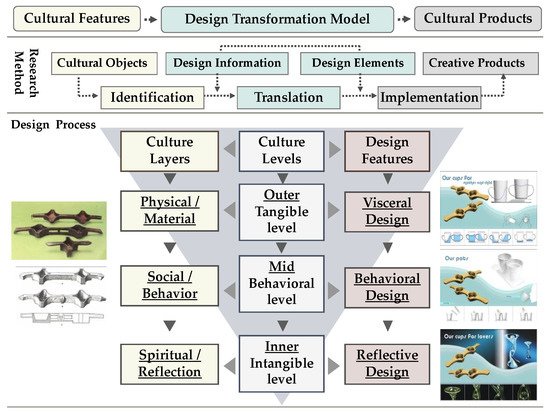Your browser does not fully support modern features. Please upgrade for a smoother experience.
Please note this is a comparison between Version 1 by Yikang Sun and Version 2 by Nora Tang.
For aboriginal peoples, sustainability results in benefits for future generations. The concept is applied to secure a balance between human beings and the environment. Aborigines are a source of sustainability strategies that can contribute to service industries. Through education and communication of service innovation, sustainability can be achieved.
- sustainability
- service innovation
- experience design
- revitalization
1. From High-Tech to High-Touch
Davis [1][10] proposed the technology acceptance model, which takes usability and ease of use as the main factors of design. Much earlier, Louis Sullivan (1856–1924) addressed the slogan of “form follows function” which became an important principle for examining the feasibility of design. In Taiwan, the development of manufacturing progress includes three stages, from original equipment manufacturing (OEM) to original brand manufacturing (OBM) [2][11]. In the OBM phase, designers have begun to integrate the emotional aspects of user experience into product design. Consequently, emotional design has become a key factor in product innovation. Thus, the emphasis of design has shifted “from Function to Feeling”, “from Use to User”, and finally “from High-tech to High-touch” [3][4][5][12,13,14]. In discussing the respective demands of consumers and product designers, Lin et al. [6][15] argue that in the evolution of the cultural and creative industries based on the 4C model (Creative, Cheerful, Collective, and Cultural), the emphasis of consumers has gradually shifted from physiological needs to aesthetic experience, while the emphasis of product designers has gradually shifted from function to experience, and is now in the process of shifting to culture, a process in which the 4C model is taking on a twin stage consisting of humanities and technology, beginning with creativity, and proceeding to enjoyment, choice, and culture, as shown in [2][6]Figure 1 [11,15].

Figure 1. Framework of cultural creative industry’s 4Cs. (Reprinted with permission from [11,15]. Copyright 2014, 2015 Lin, R. et al.).
Thus, due to the important changes in both consumers and manufacturers, increasing emphasis is being given to the emotional design stage of high-touch, aesthetics, and culture. Far from being limited to product design, this shift from high-tech to high-touch is also having a major impact on service innovation.
2. Local Revitalization in the Aboriginal Communities
Aborigines follow an understanding of the traditional belief system. In the aboriginal language, “Gaga”, aboriginal ecological strategies advocate nature and human symbiosis that can contribute to well-being in Taiwan [7][16]. The local environment can be used to increase interaction and understanding between locals and visitors [8][17], in the process of which local residents gain an enhanced sense of local identity. Moreover, local revitalization is multifaceted by nature and can include such elements as craft design, space arrangement, and service industry activities [9][18].
Sustainability has already become a vital development issue in aboriginal communities. It requires giving simultaneous consideration to the environment, society, and economy [10][11][19,20], since the benefits derived from each of these areas have a definite impact on a community’s attitude toward development [12][4]. Service industries’ development exerts mutual effects in economic, social-cultural, and environmental dimensions that change the host community’s living experience [12][4].
Sustainable development can also serve as a practical stage for local revitalization, in that cultural heritage can become the driving force for sustainable development, and authenticity is a core value of culture [12][13][4,21]. Cultural exploration is the most important factor attracting tourists to aboriginal cultural festivals [14][22]. Sustainable development strategies are responsible for the historical-cultural context and the uniqueness of the community. Moreover, community-based approaches to development are the most effective and sustainable ones [15][23]. There are a variety of intangible elements of culture in aboriginal communities, including spoken stories, seasonal community activities, food, clothing, dance, way of life, and even memories [15][23].
For indigenous peoples, they follow their ancestors’ ideas and have created a different lifestyle. The culture of indigenous peoples and their artifacts are full of human nature, and how to add value through creativity, supplemented by elements of science and technology, both to preserve tradition and meet contemporary needs, is an urgent issue to be solved. In short: (1) From Function to Feeling, (2) From Use to User, and (3) From High tech to High touch (see Figure 2).

Figure 2. A framework of the relationship in humanity and technology. (Source: this study).
3. The Cultural and Creative Industries
Cultural product design is a process of rethinking or reviewing cultural features and then redefining them in order to design a new product to fit into society and to satisfy consumers with culture and aesthetics [16][17][18][24,25,26]. Hsu, Lin, and Lin [19][27] addressed a pattern for cultural product design which is (1) the idea is inspired from culture; (2) the idea must be formed into a product; (3) the product should be used in daily life; then (4) successes in branding are required, as shown in Figure 3.

Figure 3. A model of the cultural and creative industries. (Adopted from [28]. Copyright 2016 Lin, R. et al.).
Hence, culture is the foundation of the cultural and creative industries, wherein cultural elements are creativity transformed into product designs that are integrated into daily life, finally establishing a brand image. In this study, culture is seen as a kind of way of life that groups people who have used a similar product and shaped a particular lifestyle.
Furthermore, Lin et al. [2][6][11,15] also proposed a model for cultural product design. Thus, the natural environment and local culture are the key elements of cultural products in the local service industry, wherein visitors engage in activities of local cultural rituals, in the process of which they gain a personal experience of the local culture [8][17]. Therefore, based on the previous studies [2][6][19][11,15,27], the cultural and creative industries are divided into a cultural phase consisting of nature and culture, and a production phase consisting of the creation of distinctive products relating to daily life, as shown in Figure 3.
4. Experience Design
Pine II and Gilmore formulated a model of the experience economy based on the value generated by economic activities, in which experience is regarded as a type of economic output, as well as an added-value commodity, such that the value generated by economic activities can be divided into four categories: commodities, goods, services, and experience [21][29]. The process by which a designer gradually transforms a text into a product can be said to consist of four steps: (1) setting a scenario; (2) telling a story; (3) writing a script, and (4) designing a product [17][25].
In the present study, “setting a scenario” is thought of as a process of turning creative inspiration into practical ideas; “writing a script” is thought of as the linking together of elements, which are arranged by the designer into a particular structure; and creative technology is used to shape these structured elements into a particular form. This study shows how the cultural and natural resources of the cultural phase can be extracted and used as components in writing a visual script on a particular theme. The resulting experiential product is arranged in a perceptual context in such a way as to elicit a distinctive impression in the consumer.
5. Acculturation in Human–Culture Interaction
Acculturation plays an important role in cultural product design with embedded communication theory [22][30]. Communication is a process in which a message is encoded and conveyed via a particular medium to a recipient for decoding on various levels. In the case of a local festival, unanticipated and undesirable side effects include litter, noise pollution, traffic congestion, offensive behavior by tourists, and excessive commercialization, all of which tend to detract from the solemnity of what is supposed to be a sacred event. Even more problematic are external funding and the uneven distribution of the proceeds generated by the event, which can easily split a close-knit community into competing factions [23][31]. By contrast, in a sustainable approach to local development, equal or balanced emphasis is given to economic benefits, cultural preservation, and environmental protection [24][32].
In terms of culture, such an approach promotes the preservation and handing down of traditional skills, investing them with new values, both tangible and intangible, for residents and tourists alike [25][33]. Indeed, participation in cultural events is mainly motivated by the intrinsic value of the event itself, rather than by the pursuit of an instrumental value, such that authenticity is regarded as far more important than any entertainment value the event may offer [26][34]. Thus, one of the primary goals of local revitalization needs to be the preservation and handing down of local culture and traditional skills, as shown by the way in which the neglect of traditional culture or its inappropriate application often elicits a backlash from local residents. The past study appearance and physical settings of attractions were found to be the initial and most important indicators of authentic or inauthentic experiences. Other criteria for assessing the authenticity of heritage experiences include the presence of local culture and customs, constructed elements, commodification, and atmosphere [27][35]. In terms of economics, innovation is the key element for the feeling of freshness, all visiting the aboriginal sites are novelty-seekers in the aboriginal communities of Taiwan [28][29][36,37].
The media or agent by which the message of customer experience is transmitted can be staff, products, services, activities, or place, each of which has the ability to satisfy the consumer’s requirements and to create a unique experience [30][38], which can be deepened and enhanced through the manipulation of sense perception and emotion, and by the use of the product itself. Past research has found that the main factors drawing visitors to Taiwan’s aboriginal communities are traditional architecture, handicrafts, traditional customs and rituals, and nostalgia for a bygone era [31][39].
As for the communication level, in his book Emotional Design, Norman [32][40] makes a detailed analysis of product design, in which he divides the creative design process into three levels: visceral, behavior, and reflection. For creativity, how to effectively communicate with local people, interest groups, etc., is a prerequisite for the subsequent series of work. Especially when it comes to indigenous peoples, it is necessary to further grasp the unique culture, customs, and lifestyles of indigenous peoples through communication. For indigenous peoples, their unique culture has created different ways of life. For designers, if they only look at the surface and draw conclusions, it is often easy to cause mistakes. Or rather, you cannot think in terms of past mindsets. Combining the above concepts and theories, this study further proposes a communication model suitable for cultural and creative design for indigenous peoples.
